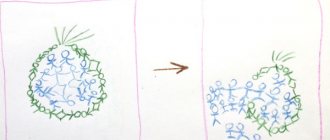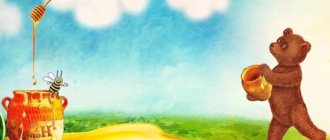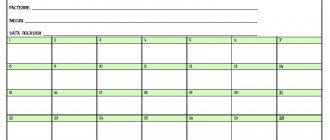Features of a child with ODD level I, ODD level II. Alalia (organization of RPPS, working methods)
Author: Tatyana Aleksandrovna Korekova , Category: Consultations for teachers · 2/2/2018 12:57:00
Good afternoon, dear teachers. At the first meeting, Olga Valerievna talked about children with disabilities and disabilities. The group of children with disabilities is not homogeneous; it includes children with various developmental disorders, the severity of which may vary. Let us remember what developmental disorders such children have.
Read all »
Math quest and how to do it
The word “quest” comes from the English “quest”, “goal, task”; this word is also used to mark tasks in games, both computer and tabletop. In other words, a quest is a chain of tasks presented in a game form.
Note! Such an event can be done with or without a plot.
For example, children aged 5–6 years are still interested in watching the story about Baba Yaga and Little Red Riding Hood, but children aged 6–7 years may feel a little awkward.
Then it is better to put the quest in a more “adult” form, calling it, say, “Sports Math Quiz,” or make a story where the main character will be a detective, and he will investigate the case of missing answers to questions in a test. If the institution has a projector, then a background video can be installed to create the appropriate atmosphere. In order not to waste time downloading, you can launch it online. It is precisely these nuances that distinguish truly entertaining mathematics for children from ordinary lessons.
Nothing makes an event more interesting for children than the opportunity to have fun
Important! It is necessary to understand that the quest is, first of all, an entertaining event, and the teacher must be prepared for the fact that the interest of children is more important than the quality of the information conveyed.
GCD on manual labor in the senior group with ideas for crafts
This is not a lesson, a test, or a test. A good math riddle for children is one in which he wanted to find the answer, but not one where the answer was complicated and boring. Also, the child must have a reason to participate in a strange and incomprehensible action. Such a reason could be a certificate or a sweet prize.
The process of creating a quest looks like this:
- Come up with a story or reason why children will have to solve certain problems.
- Divide the quest into several stages (more on this below).
- Distribute the locations, keep in mind that in order to carry out the quest efficiently, you will have to distribute the children into groups of no more than 5 people, otherwise it will not be possible to pay enough attention to everyone at each stage. (If there are not enough teachers to work in parallel, you can conduct a regular lesson with part of the group, and a quest with the other, and swap them in the next lesson. (Or conduct a KVN, but more on that later).
Each quest should have the following several parts:
- The initial stage, in which you need to explain to the children what is happening now, talk about the rules of behavior in such a lesson. It is worth limiting yourself to a few easy tasks, giving priority to the involvement and interest of children.
- The main action in which children will move around locations and solve problems.
- The culminating part, in which the winners, if any, will be awarded (the best way out here would be to allocate first place, and give the rest diplomas / awards “for active participation”, “for the best poem”, etc.).
- Summing up is an important point that many scripts miss. A child always wants to feel important and grown up; he appreciates being appreciated. It is necessary to divide the children into groups and give them the opportunity to speak out about what happened, after which they should be carefully led to the idea that mathematics is more interesting than it seemed before. At this moment, the teacher should not be too persistent: feeling that someone else’s opinion is being imposed on him, the child may close himself off from the subject for a long time.
MAGAZINE Preschooler.RF
Organization of gaming activities in the preparatory group. Mathematical quest "Piggy Bank".Author of the abstract: Isaeva E.V. Novosibirsk MKDOU No. 176 d/s “Smile”
Priority educational area: NGO "Mathematical Development" .
Developing subject-spatial environment: group room, pictures: depicting conditions for mathematical problems; letters for composing words and encoding; conditions for logical problems using Dienesh blocks, a set of numbers and mathematical symbols.
Goal: creating conditions for children to develop interest in mathematical knowledge.
Educational objectives:
- Continue to develop the ability to solve logical problems relying on exclusionary features.
- Consolidate knowledge about geometric shapes and their characteristics.
- Continue to develop knowledge about ordinal counting within 10, strengthen the graphic perception of numbers.
- Continue to form an idea of equality, strengthen the ability to correlate equality with the equal sign (=).
- Continue to develop the ability to compose mathematical problems based on pictures and make mathematical notations.
Educational tasks:
- Continue to develop the ability to work as a team and follow the rules of behavior.
- To form an understanding of how interesting and important it is to act together and gain new scientific knowledge.
Introductory part (motivational, preparatory stage)
The teacher is having a conversation with the children on the topic of letters to friends, during the conversation they hear noise in the reception area, the children go out to the reception area and notice two letters in the mailbox.
D: guys, letters have appeared in our mailbox! Let's quickly find out who they are from. Children express their guesses. Children read independently from whom and to whom.
Q: letters from the Queen of Mathematics!
Look at two envelopes, it says that you and I can open one right now (there is a letter in the envelope with task No. 1), and to open the other, you need to get 10 coins.
They read the letter.
Hello children, I found out that you really love mathematics - this makes me happy! I have prepared a gift for you, where it is written in a sealed envelope, you can open it by getting 10 coins. You can get coins by completing 5 tests, look for clues and coins. The first test awaits you on your tables. Good luck!
Q: Everything is clear, the queen invites you and me to take part in the quest.
That’s great, because the quest is a very interesting journey! Ready?! Let's split into 2 teams.
Would you like me to tell you the secret to successfully completing the quest?
- Don't interrupt each other.
- Act together.
- Be careful.
V.: Since you and I are ready, let’s begin!
Main part (content active stage)
1 “Let’s fix the carpet . Children receive diagrams with several signs on
exception. Ref: this figure
solution: big yellow circle.
Schemes are selected depending on the level of preparedness of children.
Approach the tables; on them there are Dienesh blocks and conditions for the task. At the signal, we begin to solve the problem, and our carpet will help us check whether you have decided correctly; if so, then a patch on the carpet will do (overlay method). On the back of the carpet, children find a clue where to look for challenge No. 2 and 2 coins.
Well done, the next task for you and me is in the reception area, let's go quickly!
2 "Settled in with neighbors"
Guys, in front of you lies a sheet on which houses with numbers are drawn, you need to write in the neighbors of the numbers with a pencil. We take three options for each team.
Great, let's look at the hint where to look for the next task (written on the back of the sheet with the task), look for the task where the girls often play (the kitchen corner), you will find the coins there.
3 "Encoding"
Before you is a coded word, in order to decipher it, you need to put the corresponding letters instead of numbers, be careful!
1 2 3 4 5
A V R N O
3 1 2 4 5
Words used for the cipher: equal, minus.
You are just super, let's look for a hint on where to move next (read on the back, the hint is from an adult in the group, this is not a teacher). They find a clue and move to the reception area. Back in the waiting room, in the cubicle of a child whose birthday is in April, go ahead!
4 "Fill and level the baskets"
Children receive sheets depicting 2 baskets of apples, with an equal sign between them.
Your task is to finish drawing the apples in the baskets so as not to break the equal sign.
Wow, how smart and clever you are, you can cope with all the tests, but what is this in my pocket (the teacher takes a piece of paper with a hint from his pocket, and later finds coins), wait, this is not mine, whose is it? Or maybe this is a hint, let's see!
A task awaits you where everyone can see themselves! Let's go look!
(On the mirror in the group).
5 “Make up a task and write it down”
Look carefully at the picture, come up with a problem, and use cards to write down a mathematical notation for it. Coins appear quietly on the table immediately after completing the task.
Great, let's count the coins!
Each team collected five coins, but to open the second envelope you need 10 coins, what should you do?
Children's answers 5+5 =10
That’s right, open the envelope (card diagram: the gift is located:
- not in the group, not in the kitchen, not in the toilet room (children's answers - in the reception area))
- in the booth there is a girl with dark hair whose name begins with the letter N. (children's answers - Nastya).
Let's go quickly!!!
(Children find a mathematical constructor)
Final part (reflective stage)
Q: You guys are great, I had so much fun with you, what about you?
D: yes!
Q: Today we completed many difficult tasks, was it difficult for you?
D: no.
Q: It’s because you are a great team!
I suggest you go play a new game!
| Next > |
Quest – game “Journey to the Land of Mathematics” for the older group.
Trirog
.
One of the oldest symbols of the sun, as well as the sign of the holy number “three”.
Swastika, svarga.
Sign of holy fire, sun and perpetual motion. One of the oldest signs in general. Its first images are found on the products of primitive hunters, and this is many thousands of years ago! According to popular beliefs, svarga foreshadowed good and protected from dark forces. Varieties of the swastika are widely used not only in pysankar-making, but also in embroidery, ceramics, and wood carving.
Ruzha, mug, Rosetta, star.
Symbolizes the sun and the morning dawn. Contains an oblique cross, a straight cross, as well as left-handed and right-handed swastikas. In folk symbolism it is an unchanging symbol of love. Giving a gun pysanka meant a declaration of love.
Infinity, or crooked.
A sign of one of the main elements - water. Being necessary for all living things, water could simultaneously be angry and unforgiving during the spring flood. Surprised by the power and versatility of the properties of water, our ancestors used its sign to denote eternity.
Rakes, combs, triangles with combs.
Belong to symbols that are associated with water. Depicts clouds and rain. Easter eggs with rakes were made during droughts, thinking that by writing this sign, the long-awaited heavenly waters could be summoned.
DEER
Symbol of prosperity, wealth. It has existed since the times of primitive hunters, when the meat of this animal was the main food, the skin was needed for sewing clothes and building housing, and weapons and jewelry were made from bones and horns. In folk mythology, the heavenly deer carries the sun on its antlers.
Horse
.
The horse symbol is also associated with sun worship. According to ancient legends, the sun rides across the sky in a chariot drawn by fiery horses. In Christianity, the horse is the image of a fearless prophet of faith, unrestrained, ready for self-sacrifice.
Bird.
Symbol of the origin of life, fertility, offspring, prosperity, half-earthly, half-heavenly creature. The rooster was considered a conductor of God's sun and a guard against evil, while the dove was a symbol of love, fidelity and harmony. In Christianity, the bird is a symbol of ascension to God.
Duck's feet, God's hand, glove.
The bird's footprint was also a talisman, like the handprint of the pagan Sun God, who, as we have already said, was associated with a bird in ancient times. Such signs symbolized power, patronage, integrity - everything that was associated with respect for the hand.
Tree of life, or flowerpot.
According to popular beliefs, in the middle of heaven there is a large tree - the Tree of Life. It covers the entire paradise and has the leaves and fruits of all the trees. It is on it that three brothers are located - the Sun, the Moon and the Rain. With the advent of Christianity, this symbol acquired its deep meaning associated with the moment of the fall of the first people. Designates the axis of the universe, which connects three worlds - underground, earthly and heavenly, the so-called fabulous “three kingdoms”. A symbol of ever-renewing nature.
Rules for conducting mathematical KVN and coming up with jokes for preschoolers
Such an event is a much more difficult task than it seems at first glance. The whole problem is that the humor of children and the humor of adults are two completely unrelated categories.
Note! The best solution to this problem would be to replace humor with some other amateur activity, say, theatrical skits or songs.
This will make it much easier to create joke math problems for preschoolers. Children will be able to prepare such work together with their parents, gathering at each other’s houses (of course, if the math quest was originally planned to be carried out in the older group).
Indicators of the development of a child’s creative thinking
Note! It is imperative to ensure that there is no inequality between children, and that sufficient time is given to everyone.
It is better to leave the humorous part of the event entirely in their care. It should be remembered that it should be funny for the main participants of the holiday, and not for the parents and teachers who have gathered to watch them. A moment that is humorous for adults may not be funny for children.
At such an event, a child will be able to solve even the most difficult problem for him.
summary of quest games in mathematics in the preparatory group
Scenario of a math quest game for children in the preparatory group “Journey to the Mysterious Islands”
Compiled by: Pie Ainura
Target:
To create favorable conditions for the formation of elementary mathematical concepts in preschoolers.
Tasks:
1.To consolidate temporary concepts through the development of attention and creative imagination.
2.Skills in using diagrams in solving mathematical and logical problems;
3. The ability to construct from large building materials according to a diagram, according to the instructions of the teacher, work in a group, in pairs.
4.Create conditions for the development of logical thinking, intelligence, attention, develop ingenuity, visual memory, imagination.
5.Cultivate interest in mathematical studies.
Materials
: 6-part map, ship diagram, African animals for flannelgraph, geometric figures, Cuisenaire's wand game, numbers, musical accompaniment: sound of the sea, calm music for relaxation, children's songs. Treats for children (sweets)
Progress of the game situation:
Guys! Would you like me to tell you an interesting story? It happened a very long time ago. The captain of the pirate ship "Shark", anticipating his last hour, gave his sailors a treasure map as a sign of gratitude for their long and faithful service. They decided to sail to this place. But as soon as the treasured strip of land appeared on the horizon, a serious battle for the map began among the sailors. And since everyone tried only for themselves, it was torn into small pieces. The brutal hunt for her continued for a long time, but suddenly, as if as a punishment for greed, a terrible storm hit the ship, and a few hours later the ship sank not far from the shore. Most of the crew died in the rough waters. What happened to the card? Some pieces of the map were hidden by the surviving pirates on land. The surviving pirates tried to find parts of the ill-fated map and collect it, but no one succeeded.
A lot of time has passed since then, and only two pirates have survived to this day - Bill and Jack. Aged and weakened, they are no longer able to get to the treasure on their own, and they ask us for help to help them find the map. Well, guys, let's help Bill and Jack find the map?
But it won't be easy. You need to complete all the tasks to find the map.
— Do you want to become pirates and visit different islands to collect all the parts of the map?
(children's answers)
- But how do we get to the islands? That's right, you can get there by ship.
But we don't have it. How to be?
Maybe you can tell me what a ship can be built from? (children offer their options) correctly, it can be built and the children build a ship from commercial building material based on the diagram.




